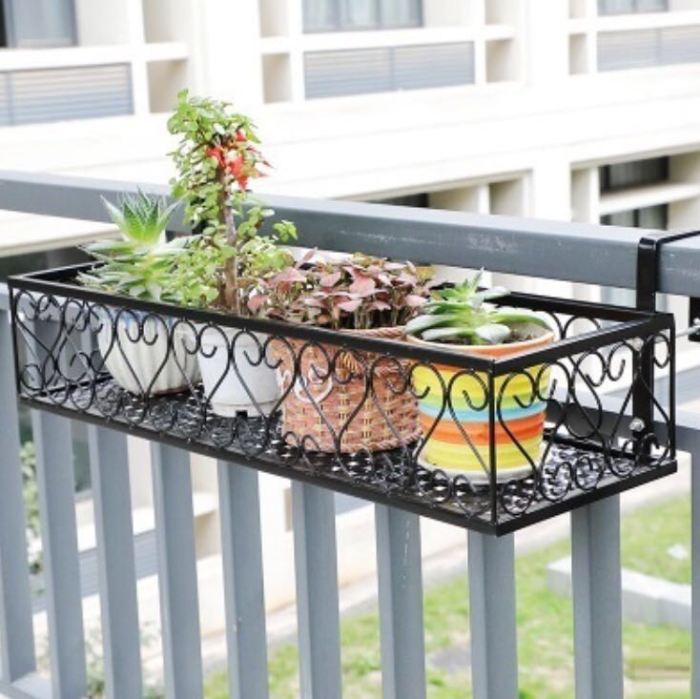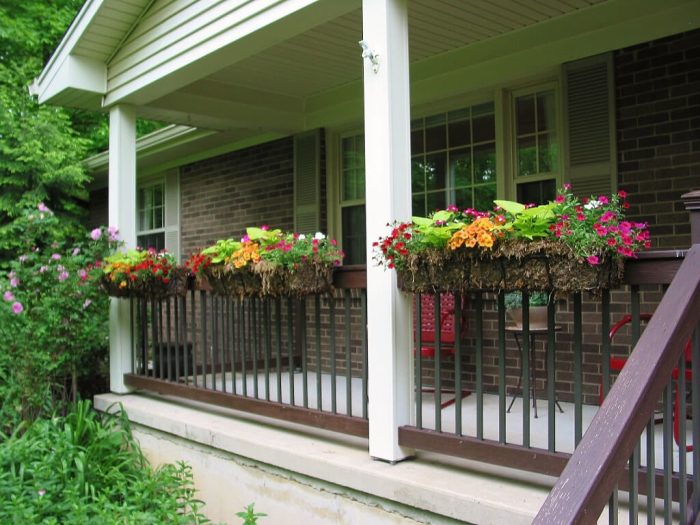Hanging plants balcony railing is a captivating trend that transforms balconies into lush and inviting outdoor havens. Whether you have a spacious terrace or a cozy urban balcony, incorporating hanging plants into your railing can create a stunning vertical garden that adds color, texture, and a touch of nature to your outdoor space.
In this comprehensive guide, we will explore the world of hanging plants balcony railing, providing you with everything you need to know about selecting the right plants, installing them securely, and caring for them to ensure they thrive and beautify your balcony for seasons to come.
Popular Plant Varieties for Balcony Railings

Adorning balcony railings with hanging plants can transform them into verdant oases. When selecting plants for this purpose, consider factors like sunlight exposure, size, and growth habits. Here’s a comprehensive list of popular hanging plants that thrive in balcony railing environments:
For Sunny Balconies:
- Petunias:Cascading blooms in vibrant colors
- Geraniums:Heat-tolerant with showy flowers
- Lantana:Profuse blooms in clusters
- Fuchsias:Elegant hanging baskets with intricate blooms
For Shaded Balconies:
- Impatiens:Shade-loving with colorful blooms
- Begonias:Wax-like flowers in a range of hues
- Coleus:Foliage plants with vibrant patterns
- Ferns:Lush greenery that adds a touch of elegance
Compact Varieties for Small Railings:
- Trailing Lobelia:Delicate trailing stems with blue or white flowers
- Million Bells:Compact and heat-tolerant with abundant blooms
- Ivy Geraniums:Cascading foliage with small flowers
- Bacopa:Creeping stems with star-shaped flowers
Vining Varieties for Long Railings:
Hanging plants on balcony railings can add a touch of greenery and vibrancy to your outdoor space. However, if your balcony receives limited sunlight, it’s important to choose plants that can thrive in low-light conditions. Explore our guide to what hanging plants don’t need sunlight to find the perfect plants for your balcony railing, ensuring a lush and inviting atmosphere.
- Morning Glories:Rapid-growing vines with trumpet-shaped blooms
- Clematis:Woody vines with large, showy flowers
- Mandevilla:Tropical vines with glossy leaves and funnel-shaped blooms
- Honeysuckle:Fragrant vines with tubular flowers
Installation and Care s
Ensuring the secure installation and proper care of hanging plants on balcony railings is crucial for their well-being and safety. This guide provides comprehensive s for installing and caring for hanging plants, ensuring they thrive in their elevated surroundings.
Installation Methods
- Brackets and Hooks:Metal or plastic brackets and hooks are commonly used to securely attach hanging plants to balcony railings. Choose hardware that is appropriate for the weight and size of the plant and railing.
- Rope or Chain:Rope or chain can be wrapped around the railing and the hanging basket, providing a stable and adjustable way to suspend plants. Ensure the rope or chain is strong enough to support the weight of the plant and basket.
- Tension Rods:Tension rods can be used to create a sturdy support system for hanging plants on railings. Place the rod between the railing bars and adjust it to create tension, providing a secure hold for the plant.
Care s
Proper care is essential for maintaining healthy and vibrant hanging plants. Here are some key care s:
Watering
Hanging plants require regular watering, as they are exposed to more wind and sun than ground-level plants. Check the soil moisture regularly and water when the top inch of soil feels dry to the touch.
Hanging plants on balcony railings add a touch of greenery and ambiance to outdoor spaces. However, some may wonder if such placement brings bad luck, as certain cultures associate hanging plants with negative energy. While the validity of these beliefs remains a matter of personal interpretation, it’s important to consider the practical benefits of hanging plants on balcony railings, such as providing privacy, filtering sunlight, and attracting wildlife.
Fertilization
Fertilize hanging plants every few weeks during the growing season. Use a balanced liquid fertilizer diluted to half strength. Fertilization provides essential nutrients for healthy growth and blooming.
Pruning
Regular pruning helps maintain the shape and size of hanging plants. Remove dead or damaged leaves and stems, and trim overgrown branches to encourage new growth and prevent overcrowding.
Hanging plants are a great way to add some greenery to your balcony or patio. If you have a balcony that gets full sun, there are a number of plants that will thrive in these conditions. Some of the best hanging plants for full sun include geraniums, petunias, and hanging plants for full sun . These plants are all relatively easy to care for and will provide you with beautiful blooms all summer long.
When choosing hanging plants for your balcony railing, be sure to select plants that are the right size for your space. You also want to make sure that the plants are getting enough sunlight and water.
Aesthetic Considerations and Design Ideas

Hanging plants on balcony railings can transform them into vibrant and inviting outdoor spaces. To create visually appealing arrangements, consider the principles of color combinations, textures, and vertical layering.
Color combinations can create a harmonious or contrasting effect. For a harmonious look, choose plants with similar hues, such as shades of green or purple. For a contrasting effect, pair plants with complementary colors, such as red and green or blue and orange.
Texture and Vertical Layering
Texture adds visual interest to hanging plant arrangements. Combine plants with different leaf shapes and sizes, such as ferns, succulents, and trailing vines. Vertical layering creates a sense of depth and movement. Place taller plants in the back and shorter plants in the front, or hang plants at different heights using macrame hangers or tiered plant stands.
DIY Projects and Customization

Transform your balcony railing into a vibrant oasis with customized hanging planters and trellises. Embark on creative DIY projects to enhance the aesthetics and functionality of your outdoor space.
Embrace sustainability by upcycling or repurposing materials such as old pallets, wooden crates, or discarded bottles. Unleash your creativity and design unique hanging plant displays that reflect your personal style and contribute to a greener environment.
Custom Hanging Planters
- Materials:
- Wooden planks or plywood
- Screws or nails
- Drill or screwdriver
- Sandpaper or sanding block
- Wood stain or paint (optional)
- Chain or rope for hanging
- Steps:
- Cut the wooden planks to desired sizes and shapes for the planter base and sides.
- Assemble the sides and base using screws or nails.
- Sand the planter smooth to remove any splinters or rough edges.
- Apply wood stain or paint for added durability and aesthetics.
- Attach the chain or rope to the planter for hanging.
Upcycled Hanging Planters, Hanging plants balcony railing
- Materials:
- Old pallets or wooden crates
- Drill or screwdriver
- Screws or nails
- Sandpaper or sanding block
- Wood stain or paint (optional)
- Chain or rope for hanging
- Steps:
- Disassemble the pallet or crate, if necessary.
- Sand the wood to remove any rough edges or splinters.
- Apply wood stain or paint for added durability and aesthetics.
- Attach the chain or rope to the planter for hanging.
Safety and Maintenance Tips
Hanging plants on balcony railings can be a beautiful and practical way to add greenery and ambiance to your outdoor space. However, it’s important to prioritize safety and regular maintenance to ensure the well-being of both your plants and yourself.
Safety Considerations
- Choose sturdy containers and brackets:Ensure that the planters and brackets used to hang your plants can withstand the weight of the soil, water, and plant. Check their load capacity and choose options that are rated for outdoor use.
- Securely attach planters:Use bolts, screws, or other appropriate hardware to securely fasten the planters to the railing. Ensure that they are level and stable, preventing any wobbling or movement.
- Consider wind conditions:Strong winds can pose a hazard to hanging plants. Choose wind-resistant varieties, and consider adding additional support or windbreaks to prevent them from falling or causing damage.
- Avoid overloading the railing:Distribute the weight of the hanging plants evenly along the railing. Overloading can strain the structure and increase the risk of accidents.
Regular Maintenance
- Cleaning:Regularly clean the planters, brackets, and railing to remove dirt, debris, and algae. This prevents rust, mildew, and other problems.
- Pest control:Inspect your plants for pests regularly and take appropriate measures to control them. Use organic methods or consult with a professional if necessary.
- Watering:Water your plants regularly, especially during hot and dry weather. Adjust watering frequency based on the specific needs of each plant variety.
- Seasonal adjustments:During extreme weather conditions, such as high winds or cold temperatures, take steps to protect your hanging plants. Move them indoors or provide additional shelter as needed.
By following these safety and maintenance tips, you can enjoy the beauty and benefits of hanging plants on your balcony railing while ensuring the well-being of your plants and the safety of your outdoor space.
Outcome Summary: Hanging Plants Balcony Railing

With careful planning and proper care, hanging plants balcony railing can transform your balcony into a vibrant and inviting outdoor oasis. Whether you opt for lush greenery, cascading flowers, or a combination of both, these vertical gardens will add a touch of nature to your urban space, creating a serene and refreshing atmosphere that you can enjoy all year round.
Query Resolution
How do I choose the right hanging plants for my balcony railing?
Consider factors such as sunlight exposure, balcony size, and plant growth habits. Trailing plants like ivy and petunias are ideal for cascading over railings, while upright plants like succulents and ferns can add height and variety.
What is the best way to install hanging plants on my balcony railing?
Use sturdy hooks or brackets that can securely support the weight of the plants and their containers. Ensure the hardware is weather-resistant to prevent rust and corrosion.
How often should I water my hanging plants?
The frequency depends on the plant species, sunlight exposure, and weather conditions. Check the soil regularly and water when it feels slightly dry to the touch.